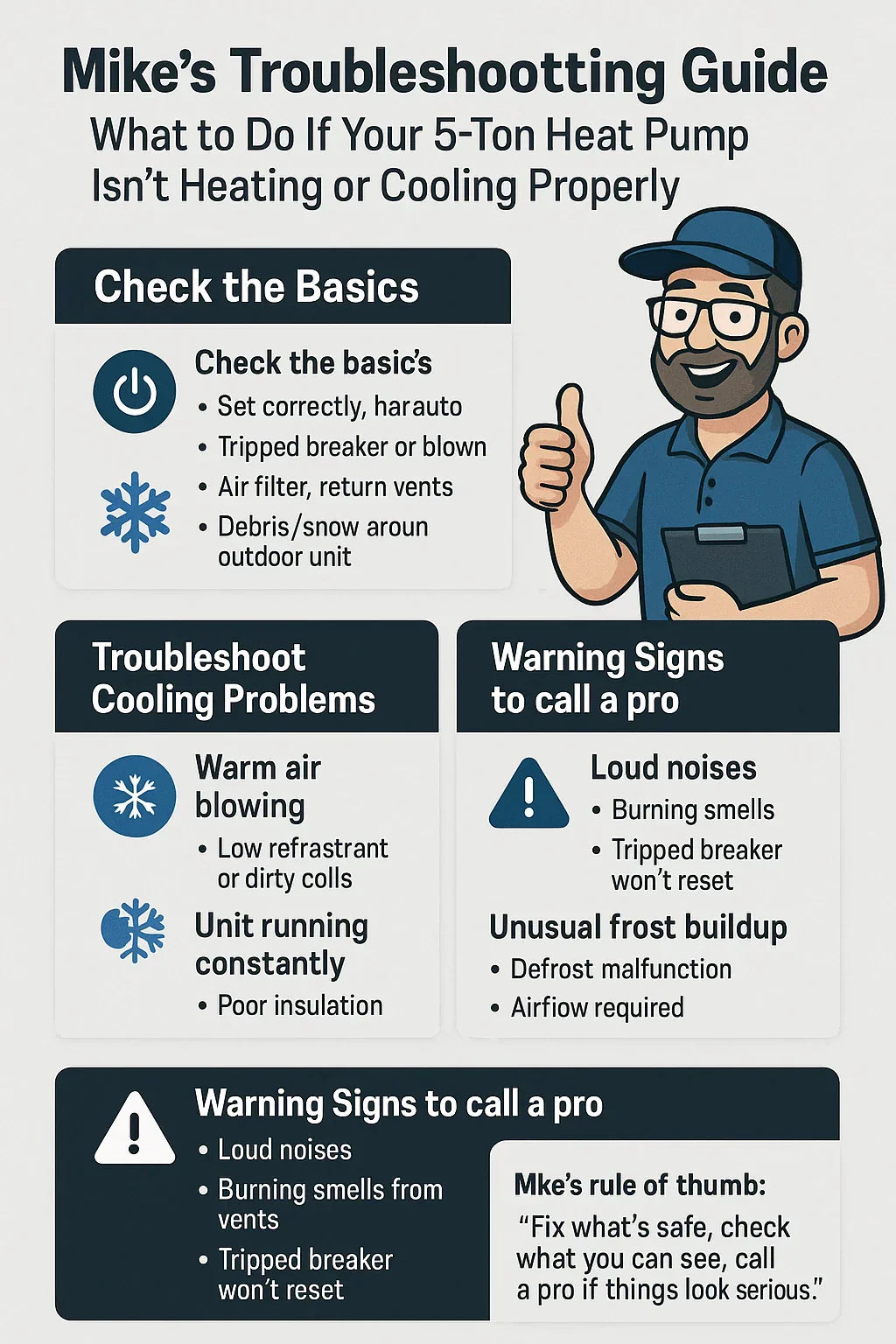If your 5-ton heat pump stops heating or cooling the way it should, it doesn’t always mean you need an expensive repair. Many problems have simple solutions you can handle yourself before calling a pro. As Mike Sanders always says: “Check the basics first—often the fix is right in front of you.”
This guide walks you through practical troubleshooting steps, helps you know when to call a professional, and shows you how to prevent future issues.
🔌 Step 1: Check the Basics
Before assuming the worst, run through these quick checks:
-
Thermostat Settings: Make sure it’s set to heat, cool, or auto, and that the temperature is set correctly.
-
Power Supply: Check for tripped breakers, blown fuses, or a disconnected switch.
-
Air Filters: Dirty filters restrict airflow and can cause the system to overheat or freeze up. Replace or clean if necessary.
-
Outdoor Unit: Clear away leaves, snow, ice, or other debris blocking the coils.
Mike’s Tip: “A clogged filter is the number one reason homeowners think their system is broken. Change it before you panic.”
🧊 Step 2: Troubleshoot Cooling Problems
Warm Air Blowing in Summer
-
Low Refrigerant: Requires a pro to recharge and find leaks.
-
Dirty Coils: Clean with a hose or coil cleaner.
-
Reversing Valve Issues: If stuck, the system won’t switch modes—professional repair needed.
Unit Running Constantly
-
Poor insulation or duct leaks can keep the system from ever reaching set temperature.
-
Low SEER2 systems may struggle during heatwaves.
Poor Humidity Control
-
A single-stage heat pump may be short cycling.
-
Two-stage or variable-speed units offer longer, steadier cycles for better dehumidification.
👉 Learn more: Carrier – Heat Pump Troubleshooting
🔥 Step 3: Troubleshoot Heating Problems
Cold Air Blowing in Winter
-
Heat pump may be in defrost mode temporarily.
-
Electric heat strips may not be engaging.
-
A faulty reversing valve could be stuck in cooling mode.
System Not Keeping Up in Freezing Temps
-
Standard models struggle below 30°F.
-
Cold-climate variable-speed units are designed for these conditions.
-
Backup electric resistance heat may be necessary.
Frost or Ice Buildup
-
Defrost cycle may be malfunctioning.
-
Ensure airflow isn’t blocked by snow or ice.
👉 Resource: Lennox – Heat Pump Not Heating or Cooling?
🌬️ Step 4: Airflow & Ductwork Issues
-
Leaky Ducts: Up to 30% of airflow can be lost. Seal joints with mastic or foil tape.
-
Closed Vents: Don’t shut too many; it causes pressure imbalances.
-
Blower Issues: Dirt on the blower wheel or a failing motor reduces circulation.
👉 Learn more: ENERGY STAR – Duct Sealing
⚠️ Step 5: Warning Signs to Call a Pro
-
Loud grinding, rattling, or buzzing sounds
-
Burning odors from vents
-
Breaker trips repeatedly and won’t reset
-
Refrigerant lines covered in ice
-
System more than 10 years old with frequent problems
👉 Official guidance: Energy.gov – Heat Pump Maintenance
Mike’s Tip: “When safety or refrigerant is involved, step back and call the experts.”
🧰 Tools & Supplies for Basic Troubleshooting
-
Spare Filters: Always keep a few on hand.
-
Flashlight & Inspection Mirror: To check hard-to-see areas.
-
Garden Hose: For gently rinsing the outdoor unit.
-
Screwdriver: To check vent covers.
-
Smart Thermostat: Helps monitor cycles, humidity, and energy usage.
📆 Preventing Future Breakdowns
-
Replace filters monthly.
-
Clear outdoor unit of debris every season.
-
Schedule professional tune-ups annually.
-
Install a smart thermostat for early detection of issues.
-
Keep a simple log of maintenance and service calls.
👉 Maintenance checklist: ENERGY STAR HVAC Maintenance
✅ Conclusion: Mike’s Rule of Thumb
“Fix what’s safe, check what you can see, and don’t hesitate to call a pro if things look serious.” With a 5-ton heat pump—one of the largest residential systems—you don’t want to risk major damage. By following these steps, you can avoid costly repairs and keep your system running strong for years.
In the next topic we will know more about: Noise, Size & Placement: Will a 5-Ton Heat Pump Fit Your Yard or Utility Area?







